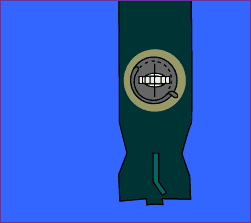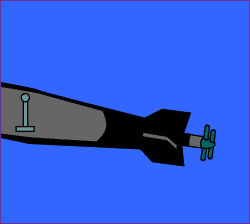 |

|
How an Automobile Torpedo Works   |
|
 See the video clip: QuickTime | RealVideo Check it out! When the wheel isn't spinning, it's easy to tilt it from side to side. But when the wheel is given a spin, its forward momentum resists side to side movement. Try it yourself. You'll need a friend or parent to spin the wheel, and be careful to keep your fingers away from the spokes. Get the software: QuickTime | RealPlayer |
The Gyroscope and Direction Control If you've ever seen a toy gyroscope, you know that it's a device that has a spinning mass, usually a disk or wheel, attached to a base that allows the axis of the spinning mass to move freely. Like a child's top, the toy gyroscope can "stand" on its tip. The reason is that the spinning mass (of the gyroscope and the top) resists a change in motion. (If you don't have firsthand experience with a gyroscope, try this: Hold the ends of a bicycle wheel's axle in each hand while you have someone spin the wheel, then try to tilt the wheel back and forth.) The WWII torpedo takes advantage of the gyroscope's resistance to a change in motion. It uses this property to allow a course to be "programmed" into the torpedo.  The axis of this torpedo's gyroscope points down the length of the torpedo. To
set the gyroscope, a ring that surrounds the gyroscope is moved (either
automatically by the submarine's computer or manually by the torpedoman) while
the torpedo is still on board. The position that the ring is set to depends on
the heading that the torpedo must take once it leaves the submarine.
The axis of this torpedo's gyroscope points down the length of the torpedo. To
set the gyroscope, a ring that surrounds the gyroscope is moved (either
automatically by the submarine's computer or manually by the torpedoman) while
the torpedo is still on board. The position that the ring is set to depends on
the heading that the torpedo must take once it leaves the submarine.Firing the torpedo opens a valve that causes pressurized air from the air chamber to spin the gyroscope. As the torpedo leaves the submarine, the gyroscope is still lined up with the submarine and with the torpedo itself; the spinning mass will keep it pointing in the same direction, even when the torpedo changes its heading. After traveling a set distance (known as the reach), the gyro mechanism kicks in. It senses that the ring and the axis of the gyroscope are not aligned. Via a connection to the torpedo's two directional rudders, it begins to turn the torpedo in the correct direction. Once the ring and the gyro axis line up, the rudders straighten out. From this point on, the gyro mechanism makes minor steering adjustments via the rudders, keeping the torpedo on a straight course. The Pendulum and Depth Control Perhaps when you hear the word pendulum you think of a clock's swinging pendulum and how, when the clock is working, it's always in motion, moving back and forth at a constant rate. The pendulum in a torpedo is not unlike the one in a clock, with one crucial exception: The torpedo's pendulum tries to stay stationary.  The torpedo's pendulum is connected to the two rudders that control depth. If
the torpedo, while it's in motion, begins to point down, the pendulum rocks
forward relative to the torpedo, causing the rudders to guide the torpedo up.
If the torpedo begins to point up, the pendulum rocks back. This causes the
rudders to steer the torpedo down.
The torpedo's pendulum is connected to the two rudders that control depth. If
the torpedo, while it's in motion, begins to point down, the pendulum rocks
forward relative to the torpedo, causing the rudders to guide the torpedo up.
If the torpedo begins to point up, the pendulum rocks back. This causes the
rudders to steer the torpedo down. So the pendulum's job is to keep the torpedo level. The torpedo's depth is controlled by a diaphragm and compressed spring, which senses the pressure of the water outside the torpedo and adjusts the rudders accordingly. How a Torpedo Works Firing Procedure Sink the Ship requires the free Shockwave plug-in Note: The text on this page describes the Mark 14, a WWII-era US torpedo. Tour U-869 | Sole Survivor | Hazards of Diving Deep 400 Years of Subs | Map of Lost U-Boats | Fire a Torpedo Resources | Transcript | Site Map | Hitler's Lost Sub Home Editor's Picks | Previous Sites | Join Us/E-mail | TV/Web Schedule About NOVA | Teachers | Site Map | Shop | Jobs | Search | To print PBS Online | NOVA Online | WGBH © | Updated November 2000 |
|